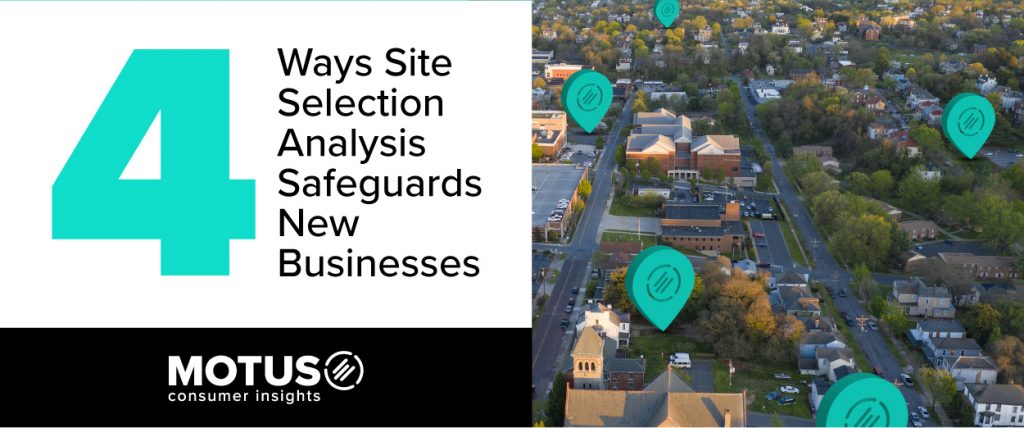There’s no way around it: business is risky. On average, 20% of new businesses fail within the first year. By year five, that number swells to around 50%.
So, what differentiates the businesses that thrive despite the odds? One major factor: location (location, location). Whether you’re starting a new business, opening a second store, or adding your fiftieth franchise location, choosing the right site is critical.
But how can you be sure you’re picking a winning location? You could rely on a realtor, but their primary motivator is closing a deal, not your long-term success. To confidently select the perfect location for your next business, you need a comprehensive site selection analysis.
What is Site Selection Analysis?
Site selection analysis is an analytics service that evaluates potential location sites for a new business. The goal is to score and rank each site’s viability, so businesses owners have reliable data to make an informed decision.
Sites are scored based on a variety of factors, including customer demand, trade area competition, and the site’s ability to meet the basic needs of the new business. Site scores range from 0 to 150. The higher the score, the more likely the site is to provide a successful foundation.
Why Conduct a Site Selection Analysis?
A professional site selection analysis isn’t simply a process designed to ease the headache of choosing a location. It helps you avoid common pitfalls that sink young businesses. Here are four ways having a site selection analysis performed by a company like MOTUS CI safeguards your business.
1. Ensuring Trade-Area Customer Demand
Ready for some economics 101: You can’t supply if there is no demand. Obvious, right? But over-estimating the market is surprisingly common. A survey found 42% of small businesses fail because there was no need for their services or products in the market.
To avoid lack of demand, sites are scored based on the size of population within its trade area. However, this is only half the battle. The trade-area population is further analyzed against your business’s customer segmentation data. This empowers you to choose a site located within a dense cluster of prospects matching your ideal customer segments.

Image 1A depicts MOTUS CI’s customer-demand heat maps. For reference, areas in red indict clusters of prospects who match the client’s top customer segments.
2. Accurately Vetting Trade-Area Competition
All too often, businesses move into a new trade area without fully understanding the level of competition they will face. Site selection analysis includes competition scoring to ensure you choose a location that isn’t overly saturated with competing businesses.
While competitor analysis may seem straightforward, often analytics companies over simplify the process. They’ll do a basic count of perceived competitors in a trade area. However, as you know, not all competitors are equal.
For example, a used car lot neighboring a Lamborghini dealership. Do they both sell cars? Sure. But their target customers, price point, and position in the marketplace are drastically different. In other words, they aren’t in direct competition.
So, when you partner with an analytics company, make sure they evaluate how directly you compete with neighboring businesses for customers and market share.
3. Building a Customer Audience Before You Open
A major challenge new businesses face is building brand awareness. For instance, you can sell the best products, but if no one knows you exist, you won’t last long. To solve this, your site selection analysis should feature location studies of potential sites and neighboring businesses.
Location studies analyze the customer segments who are visiting retail locations. This enables you to choose a site that is popular amongst your business’s most valuable customer types.
Further, your analytics company should compile this data to build an audience list of qualified customers you can target with marketing campaigns. That way, your new business is engaging customers before the doors are even open.

Image 1B depicts MOTUS CI’s map plotting of trade-area opportunities at a household level. Each red dot represents a household with a prospect who matches the client’s top customer segments. Not only can you select a site in a cluster of high-value prospects, but you can deploy marketing directly to them at a household level to boost trade-area visibility.
4. Gaining a Complete Understanding of Site Needs
Business success comes from a variety of factors. Some are universal while other factors are unique to a business. To determine the factors your business needs in a site to find success, any site selection analysis should begin by analyzing all available data.
This includes data around your business model, products and services, your core customer segments, and main competitors. This is especially important for franchise groups. Data from every location in the group should be evaluated to identify common factors in successful stores and pitfalls faced by underperforming locations.
With this wealth of data, you can select a location site that replicates success and sidesteps dysfunction experienced in failing stores.
Starting a new business or expanding into another location? Let us help you safeguard your investment. Learn more about Site Selection Analysis from MOTUS CI.




